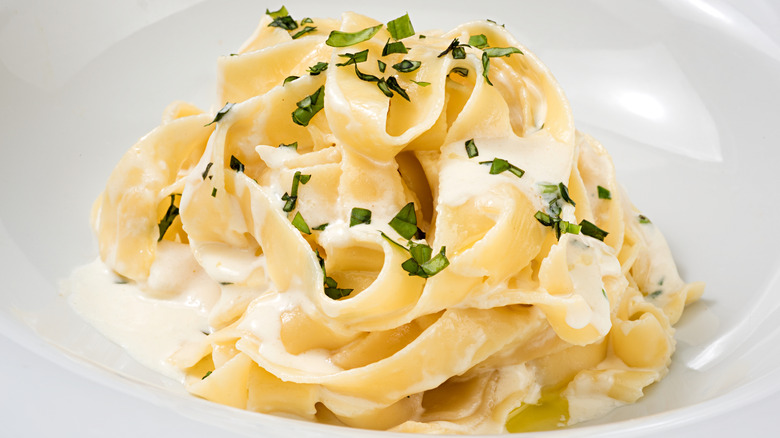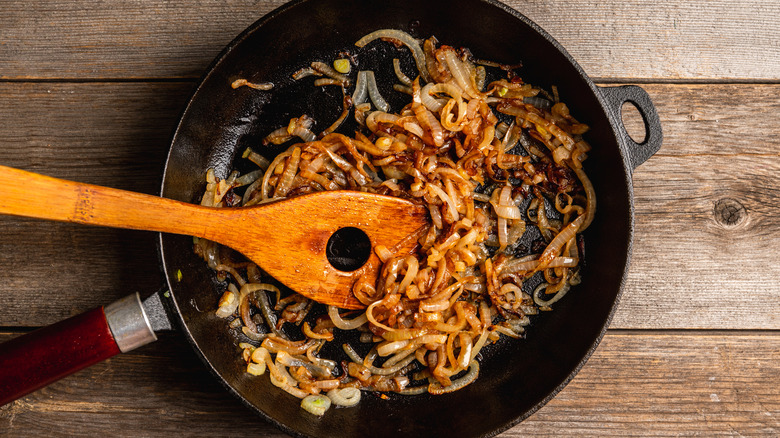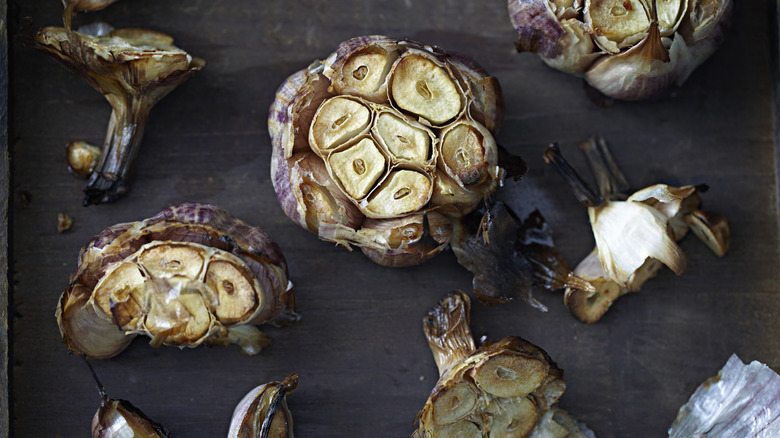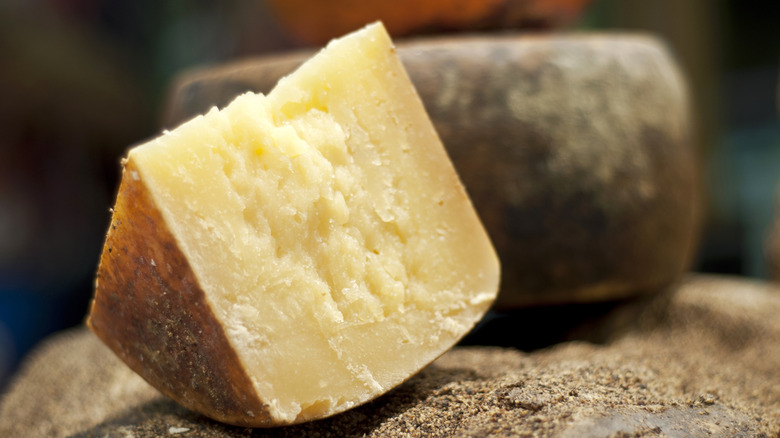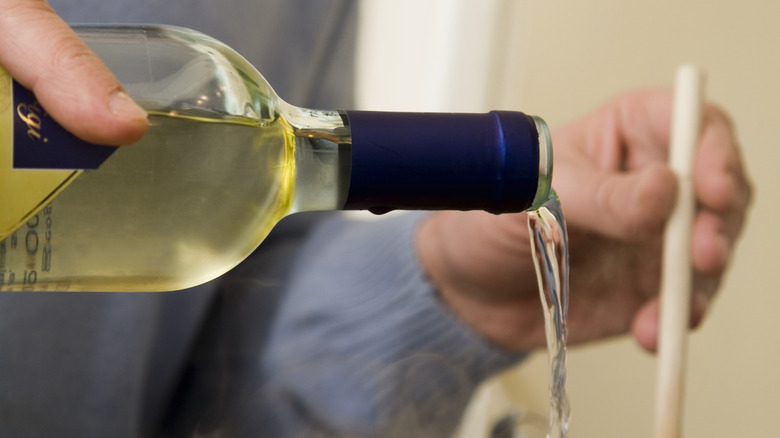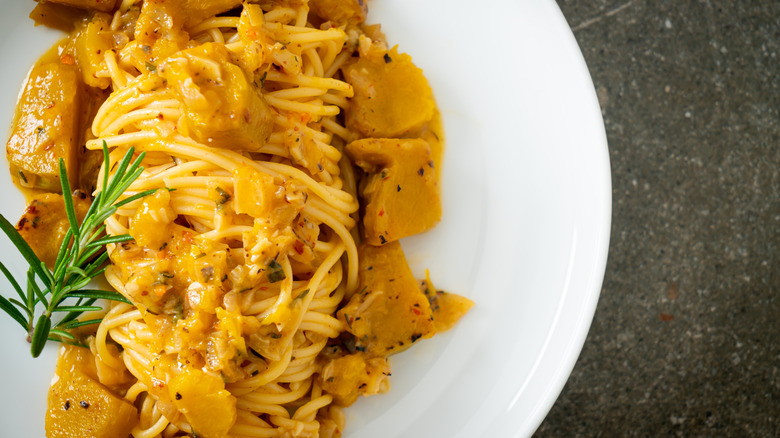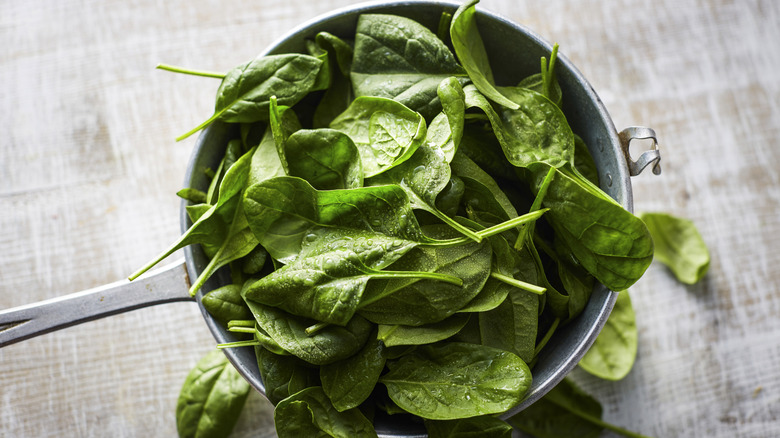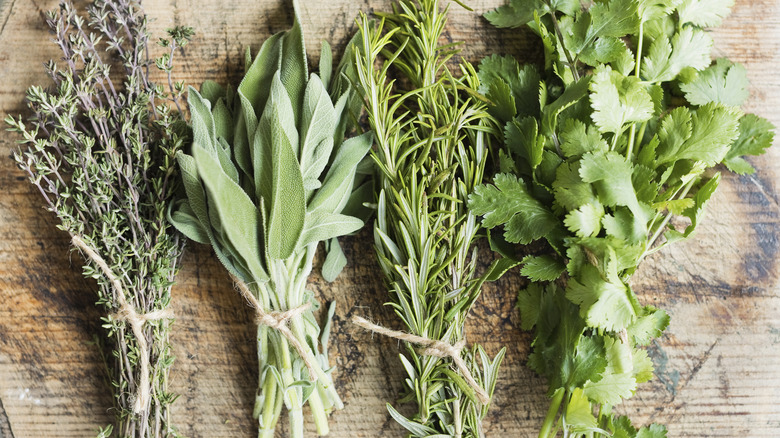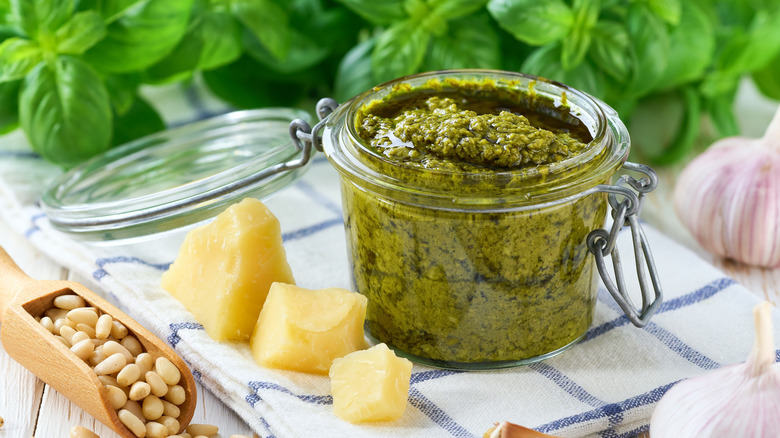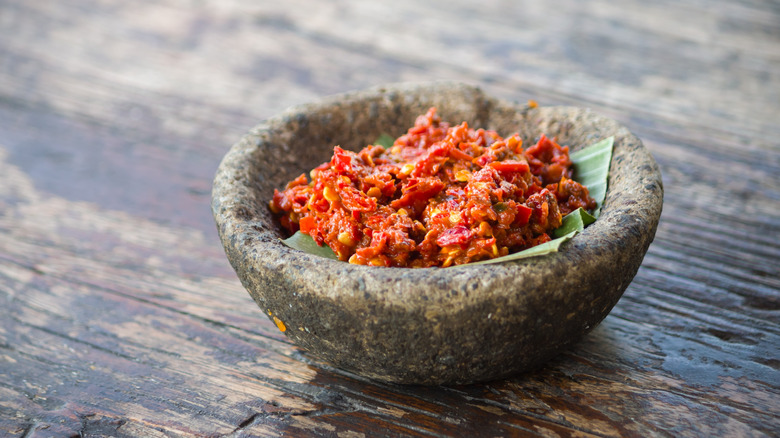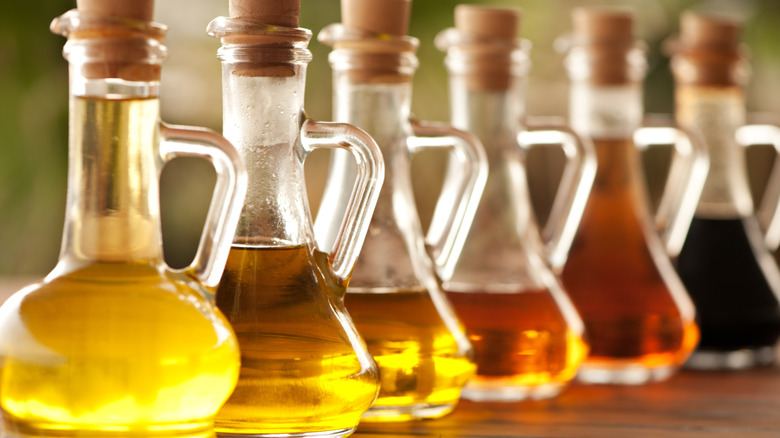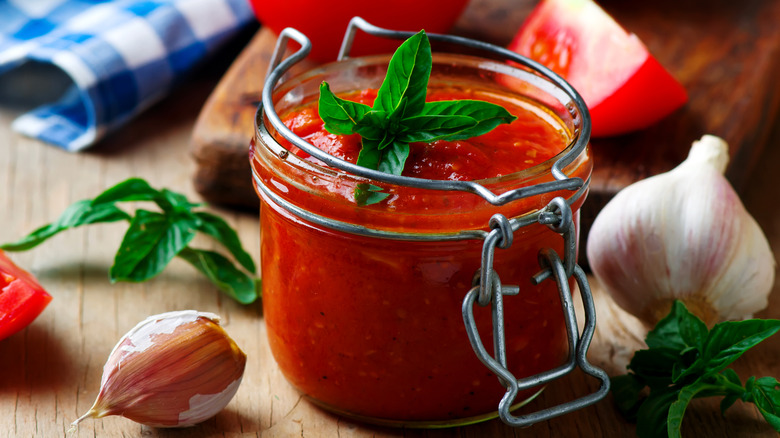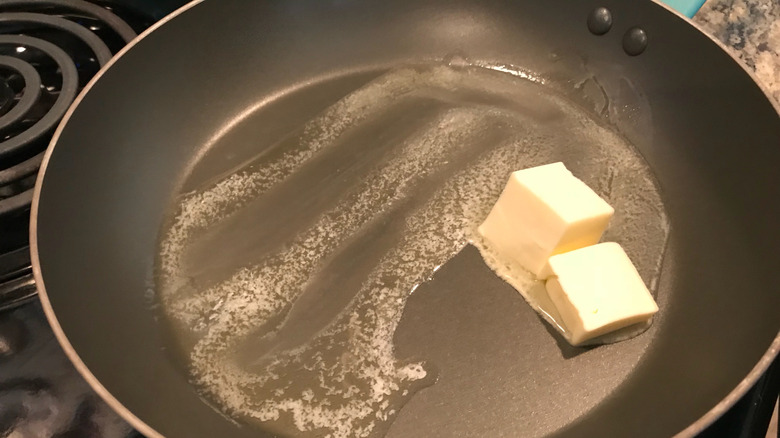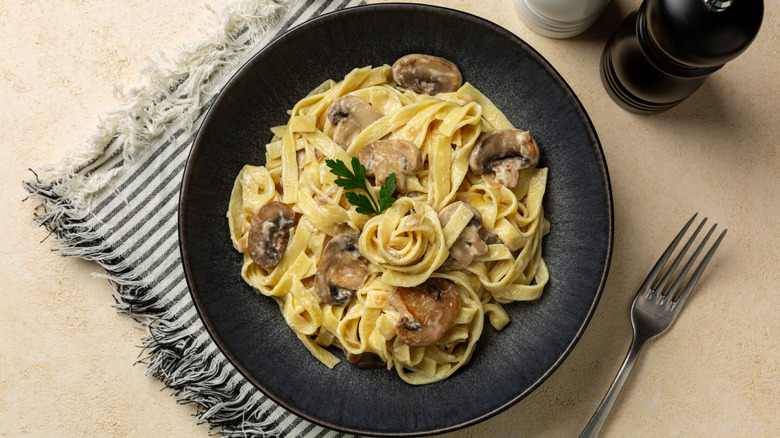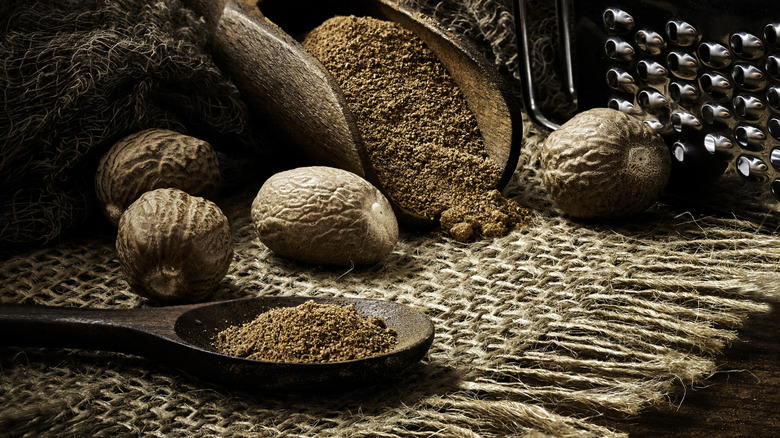14 Ways To Upgrade Store-Bought Alfredo Sauce
When you're after a quick, simple dinner, it makes sense to pick up a jar of Alfredo sauce. However, more often than not, you stir it through noodles, take a bite, and end up disappointed — it's nothing like your favorite homemade or restaurant version. Luckily, there are plenty of ways to upgrade store-bought Alfredo sauce to make it worth eating.
Alfredo sauce is named after Alfredo di Lelio, a restaurateur from Rome who made a simple yet iconic pasta dish that involved lots of butter and Parmesan. Today, Italian-American pasta Alfredo has developed to include heavy cream, making it even richer. But the versions you buy in a jar from the supermarket don't always hit the mark.
Some store-bought Alfredo sauces are better than others, so buying a decent version makes a huge difference. This sauce is best when made with simple but high-quality ingredients, but it's not always the way with jarred versions so they need a little help. Just adding a bit of extra flavor into the mix can rescue an otherwise lackluster dinner.
Mix in caramelized onions
Caramelized onions are the perfect blend of sweet, savory, and aromatic. While they're not a traditional component of an Alfredo recipe, mixing them in with a store-bought version can give it the boost it needs. Onions are the flavorful base of so many recipes, so it makes sense to use them here.
If you want to know how to caramelize onions, it's quite simple. You just slice them and cook them in a skillet on low for around 20 to 30 minutes, until they get sweet and jammy. Admittedly, though, there are plenty of ways they can go wrong. But you can follow our tips for cooking perfect caramelized onions, such as slicing the onions thinly and using a large skillet.
What's great about adding caramelized onions is that they come together in not much longer than it takes to boil a pot of water and cook your noodles. So, give them a little bit of a head start over your pasta and dinner will come together in as long as it takes to slice an onion and leave it to caramelize — about half an hour.
Roast garlic and stir it through
Garlic is a common ingredient in Alfredo sauce, including store-bought varieties. However, it doesn't always come through to its best advantage. In some store-bought versions, the garlic is sharp and overpowering. Others contain garlic powder, which gives a sauce none of the nuance of fresh garlic. So, a great solution to make jarred Alfredo more flavorful is to add roasted garlic.
If you haven't tried roasted garlic, it's sweet and mild without the punch of raw or even sautéed versions. So, even if your store-bought Alfredo sauce is already quite garlicky, a few cloves of the roasted stuff won't overwhelm it. This addition brings a complexity of flavor and a subtle garlic taste without giving you the kind of breath that will make people want to stay at least three-feet away from you at all times.
Roasting garlic is easy. You roast a bulb whole, wrapped in foil, for about 30 to 40 minutes and it's ready to use. Though, slicing a tiny bit off the top of the bulb makes it easier to squeeze out of the cloves. It has a soft, spreadable texture. So you can easily mash it and mix it into store-bought Alfredo. And if it seems like a waste to put your oven on for 30 minutes just to roast garlic, why not also roast some broccoli or other veggies to go with your dinner?
Add cheeses
One of the mistakes people make with Alfredo sauce is not adding enough cheese. Manufacturers are often looking for ways to cut costs and going easy on the Parmesan is one such option. The trouble is, it results in a subpar sauce. So, a simple way to make store-bought Alfredo instantly taste like something your grandmother whipped up is to add a boatload of cheese. That way, you still retain the essence of a classic version of this sauce.
Parmesan is the traditional cheese of choice for Alfredo. However, as our copycat Olive Garden Alfredo sauce recipe proves, pecorino Romano is often used in addition to this. Pecorino Romano is sharper and punchier than Parmesan and complements its milder, nuttier notes. This recipe calls for a cup of cheese to make four servings of pasta. This might seem like a lot, but Alfredo is meant to be cheese-heavy, so don't skip. Quality matters, too. If you're using the cheapest Italian cheese you can find, it's not going to be the best Alfredo you've ever tasted.
Now that you know which cheeses are classic for an Alfredo sauce, you have the chance to adapt it. Yes, you'd be veering away from tradition, but that's okay. Maybe you want a mild, creamy mozzarella or Edam. Or, if you're looking for something sharper, mature cheddar is always a winner. The complexity of blue cheese is something to consider, as well. These options will change the flavor of the dish, but when was any kind of cheese pasta bad?
Upgrade it with white wine
Using white wine is a simple way to add complexity to basically any dish, instantly making it seem 10 times fancier. And you can even use this trick to upgrade grocery store Alfredo sauce. It might seem like overkill, using wine in jarred sauce but you'd be amazed at the results. It no longer tastes like something you bought at the supermarket, but rather something you spent hours bent over a stove making. And if you have some leftover white wine in your fridge, better yet.
Dry white wine is the best option here, since the flavors will concentrate and sweet wines will taste even sweeter. However, something off-dry or a little sweet can work, as long as you don't mind some of that sweetness working its way into your sauce. But you can't just add it to your jarred sauce and let it simmer, it needs to cook off to mellow the flavors before you add your sauce and let them meld.
Ideally, start with some aromatics, like onions and garlic. Fry these until softened and then add your wine to the pan. Let it simmer until the wine has reduced by around a third. At this point, you can add the jarred sauce and keep cooking it until you've reached your desired consistency.
Mix in some pumpkin
Pumpkin Alfredo sauce is gaining popularity, especially during the fall when pumpkins and all kinds of winter squashes are starting to ripen. While it's normally made from scratch, you can also elevate store-bought Alfredo sauce to give it a pumpkin makeover. It adds some sweet, delicious pumpkin flavor and a bunch of extra nutrition, which is perfect for those nights when making a vegetable side dish just isn't on the agenda.
Canned pumpkin is the easiest thing to add to your jarred sauce. You just need to mix the contents of the jar with some canned pumpkin and adjust the seasonings to taste. Since you're bulking out the sauce with other ingredients, you'll need some extra salt and pepper. You may want extra garlic and an additional handful of cheese certainly won't go amiss.
But fresh pumpkin also works great, if you're willing to put in some time. Just halve your squash or pumpkin, scoop out the seeds, and roast the halves until the flesh is soft. Then, scoop it out, mash it, or blend it, and mix it with your sauce and season it as you would with canned pumpkin. You can use any winter squash you like. Butternut, dumpling, delicata, acorn — it's all good.
Blend in some spinach
Bright green and full of nutrients, spinach Alfredo sauce is the healthier cousin of the classic variety. It adds that fresh, earth flavor from spinach while staying deliciously rich and creamy. Sure, kids of spinach haters might not consider this an upgrade but many people love it.
Essentially, what you're making is a Florentine sauce. This is the name for a creamy sauce — either a béchamel or one made with heavy cream — that contains spinach. The spinach can be blended with the sauce to fully combine it, finely chopped, or just wilted in as whole leaves. You can choose depending on how you like the texture.
Fresh spinach is a great choice if you have it, since it has the freshest flavor. However, frozen spinach is one of the better frozen vegetables. It comes either chopped or in whole leaves. The chopped variety is very finely chopped, which takes some of the work out. Ideally, thaw it and squeeze out the excess moisture before using or your sauce might come out wet. But, if you don't have time, sauté the spinach to defrost it, letting the excess moisture cook off before adding the jarred sauce.
Incorporate fresh herbs
Traditionally, Alfredo isn't an herby sauce. However, when you're dealing with a tasteless jarred variety, herbs can be just the thing to level it up. And, we can all agree that eating a flavorful herb-cream pasta sauce is better than sticking to convention but winding up with a meal that tastes like wet cardboard. Plus, there are already herb-heavy variations on classic Alfredo sauce out there, so why not join in on the trend?
A bit like when you use spinach in an Alfredo, you can either stick the sauce and the herbs in the blender and give it a whizz or just chop the herbs and stir them through the sauce while it's heating. Either way will give you a kick of that fresh herb flavor. Varieties that are common in Italian food are your best bets, although it's okay if you want to branch out. Fresh basil, parsley, rosemary, and thyme are all great choices.
While it won't taste as fresh and complex, dried herbs are an option here too, if that's all you've got on hand. Raid your pantry for your finest and least dusty bottles of dried herbs and add these to your Alfredo. Even an Italian herb mix can perk up a forgettable store-bought sauce.
Stir in some pesto
Sometimes a single jarred sauce isn't great but mix it with another and you've got something greater than the sum of its parts. You should be mixing together jarred pesto and store-bought Alfredo to quickly and easily make a drool-worthy pasta sauce. Depending on your perspective, and the ratios you use, you might consider it an herby Alfredo sauce or a creamy pesto — either way, it's delicious.
Start by adding 1 or 2 tablespoons of pesto to a jar of Alfredo sauce. This will give you a notably herbaceous cream sauce that's not overwhelmingly pesto-like. Taste it and increase the quantity of pesto from there, if desired. There isn't a right or wrong ratio here, it's all about your preferences.
Now, we've talked about using jarred pesto but, of course, you can also do this with homemade. If you've reached for the jarred Alfredo, it's probably not a day when you want to make pesto from scratch. However, if you happen to have some left over in your fridge from another day, it will elevate your sauce even more.
Make it spicy
If you're the kind of person with an extensive hot sauce collection, who has got up close and personal with a Carolina reaper on more than one occasion, making Alfredo sauce spicy is the perfect upgrade. Sure, for some people, this will be a total downgrade, but spice-lovers might appreciate the extra kick. Hot peppers and other spicy ingredients can bring not just heat but flavor.
Perhaps the easiest way to make spicy Alfredo is to use a dash of hot sauce or a chili paste, such as gochujang. This way, you can just mix the spicy ingredient in with the sauce while you're heating it on the stove or in the microwave — a little stir and you're done. These types of sauces and pastes are also usually flavorful, not just spicy, improving a bland Alfredo. Start by adding a little, taste for spice, and then work from there.
However, there are other ways to spice up your sauce. You might use sliced fresh chilies or red pepper flakes. These are best bloomed or sautéed in oil before adding to the Alfredo, so it takes a little more effort. Cayenne pepper would also work, though it lacks the nuanced flavors of some of these options.
Add something acidic
Is that jar of grocery store Alfredo sauce you bought ultimately okay but just a bit ... flat? If so, the missing ingredient might be something acidic. The ingredient that will majorly upgrade your Alfredo sauce may be as simple as a squeeze of lemon juice or a splash of vinegar.
Good food is all about that elusive balance of sweet, salty, umami, bitter, and sour. Acidic ingredients take care of the sour element that store-bought Alfredo sauce can be missing. Lemon juice brings a fresh acidity with fruity, floral notes, but there are so many types of vinegars that you have a range of other options to explore. Apple cider vinegar is a fruity option that a lot of people have in their pantries. White balsamic is less popular but has the sweetness and complexity of regular balsamic with a lighter color that won't make your sauce go murky. Ultimately, you can use whatever you have available. Just start by adding a little, taste the sauce, and then gradually add more, as needed.
Mix it with marinara sauce
If you have a jar of store-bought marinara sauce, as well as your ready-made Alfredo, you can make something remarkably good. Combine the two and you get a creamy rosé sauce. If you're into these kinds of tomato-cream pasta sauces, it's the perfect solution. It's not quite as good as homemade but not far off.
The marinara sauce adds a bit of oomph to a basic Alfredo that might not be that flavorful. And, from the other perspective, the Alfredo sauce softens the edges of the marinara, which can be needed in store-bought versions as they have a tendency to be overly acidic and not that nuanced.
And, if this wasn't already rich and creamy enough, spooning in a bit of ricotta or mascarpone takes things to the next level. Who knew that mixing together two different jars of ready-made pasta sauce could be so successful?
Melt in some butter
You need a lot of butter to replicate Olive Garden's iconic Alfredo sauce. So, if this is one of your go-to restaurant versions, then butter might be what you're missing. Simply melting some butter into a store-bought Alfredo can turn it from bland to pretty darn good, actually.
Jarred options that you pick up at the supermarket don't always contain real butter. They might contain margarine or oil but butter isn't a given. This might seem strange for a dish that originated as basically just butter and cheese on pasta, but that's the way it goes sometimes. While cream and milk does a lot of work, grocery store versions of this sauce are often missing the rich butteriness of the original.
An easy way to rectify this is simply to melt a pat of butter and mix it into your store-bought sauce. If you want to add even more flavor, you could brown the butter, giving it a toasty flavor. Alternatively, you could sauté aromatics like garlic and onion in the butter.
Add mushrooms
Mushrooms aren't a traditional part of Alfredo sauce, but they make a tasty addition. With their savory umami notes, mushrooms are perfect with pasta. However, they really shine in creamy pasta dishes like Alfredo. The cream-based sauce complements them rather than overwhelming them.
All you have to do is sauté them in some olive oil or butter before mixing them with the Alfredo sauce. The cooking juices can add more savory richness to the dish. While basic white mushrooms are fine, it's fun — and delicious — to experiment with other options. Cremini mushrooms have a slightly deeper, nuttier flavor than white or button mushrooms, but they're still easy to find in stores.
Porcini mushrooms have an especially intense savory flavor that's almost truffle-like and works well in Italian dishes. They're usually found dried, though, so you need to rehydrate them before use. King oyster mushrooms have a super mushroomy flavor and a dense, almost meaty texture, making them a particularly tasty addition.
Grate in some nutmeg and add other spices
Alfredo sauce traditionally contains a little nutmeg. It's a warming, fragrant addition that takes it up a notch from just a basic cream sauce. While it's in many store-bought versions, it usually isn't all that noticeable. It shouldn't be prominent, but it should be a noticeable background note and this is often missing.
It might be that the sauce has been in a jar for a while or that basic ground nutmeg went into it, but it's easy to rectify. Grating in some fresh nutmeg is the way to go. Using pre-ground stuff just doesn't compare. A little grating of fresh nutmeg and you've got yourself an Alfredo sauce that pops.
However, you don't have to stick with tradition when adding spices to Alfredo sauce. Add a little white or black pepper, a dash of ground cinnamon, and a pinch of allspice and you're on your way to something approaching homemade. It's fine to experiment with any spices you have in your pantry too. You might discover that smoked paprika and coriander work well in an Alfredo sauce, even if it takes it in a non-traditional direction.
